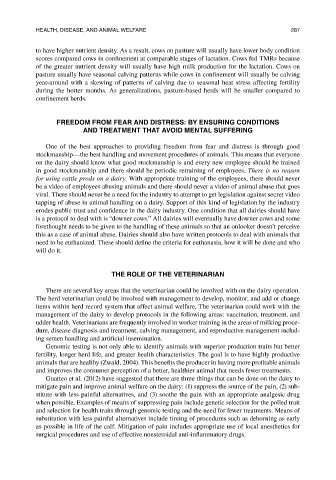Page 310 - The Welfare of Cattle
P. 310
heaLth, dIsease, and anIMaL WeLfare 287
to have higher nutrient density. As a result, cows on pasture will usually have lower body condition
scores compared cows in confinement at comparable stages of lactation. Cows fed TMRs because
of the greater nutrient density will usually have high milk production for the lactation. Cows on
pasture usually have seasonal calving patterns while cows in confinement will usually be calving
year-around with a skewing of patterns of calving due to seasonal heat stress affecting fertility
during the hotter months. As generalizations, pasture-based herds will be smaller compared to
confinement herds.
FreeDOM FrOM Fear aND DIStreSS: BY eNSUrING CONDItIONS
aND treatMeNt that aVOID MeNtaL SUFFerING
One of the best approaches to providing freedom from fear and distress is through good
stockmanship—the best handling and movement procedures of animals. This means that everyone
on the dairy should know what good stockmanship is and every new employee should be trained
in good stockmanship and there should be periodic retraining of employees. There is no reason
for using cattle prods on a dairy. With appropriate training of the employees, there should never
be a video of employees abusing animals and there should never a video of animal abuse that goes
viral. There should never be a need for the industry to attempt to get legislation against secret video
tapping of abuse in animal handling on a dairy. Support of this kind of legislation by the industry
erodes public trust and confidence in the dairy industry. One condition that all dairies should have
is a protocol to deal with is “downer cows.” All dairies will eventually have downer cows and some
forethought needs to be given to the handling of these animals so that an onlooker doesn’t perceive
this as a case of animal abuse. Dairies should also have written protocols to deal with animals that
need to be euthanized. These should define the criteria for euthanasia, how it will be done and who
will do it.
the rOLe OF the VeterINarIaN
There are several key areas that the veterinarian could be involved with on the dairy operation.
The herd veterinarian could be involved with management to develop, monitor, and add or change
items within herd record system that affect animal welfare. The veterinarian could work with the
management of the dairy to develop protocols in the following areas: vaccination, treatment, and
udder health. Veterinarians are frequently involved in worker training in the areas of milking proce-
dure, disease diagnosis and treatment, calving management, and reproductive management includ-
ing semen handling and artificial insemination.
Genomic testing is not only able to identify animals with superior production traits but better
fertility, longer herd life, and greater health characteristics. The goal is to have highly productive
animals that are healthy (Zwald, 2004). This benefits the producer in having more profitable animals
and improves the consumer perception of a better, healthier animal that needs fewer treatments.
Guatteo et al. (2012) have suggested that there are three things that can be done on the dairy to
mitigate pain and improve animal welfare on the dairy: (1) suppress the source of the pain, (2) sub-
stitute with less painful alternatives, and (3) soothe the pain with an appropriate analgesic drug
when possible. Examples of means of suppressing pain include genetic selection for the polled trait
and selection for health traits through genomic testing and the need for fewer treatments. Means of
substitution with less painful alternatives include timing of procedures such as dehorning as early
as possible in life of the calf. Mitigation of pain includes appropriate use of local anesthetics for
surgical procedures and use of effective nonsteroidal anti-inflammatory drugs.

